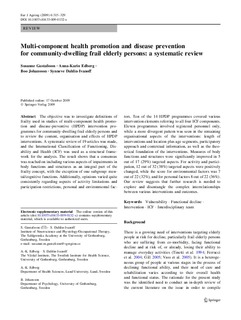| dc.contributor.author | Gustafsson, S. | |
| dc.contributor.author | Edberg, A.-K. | |
| dc.contributor.author | Johansson, B. | |
| dc.contributor.author | Dahlin-Ivanoff, S. | |
| dc.date.accessioned | 2018-01-17T12:18:06Z | |
| dc.date.available | 2018-01-17T12:18:06Z | |
| dc.date.issued | 2009 | |
| dc.identifier.citation | Gustafsson, S., Edberg, A.-K., Johansson, B. & Dahlin-Ivanoff, S. (2009) Multi-component health promotion and disease prevention for community-dwelling frail elderly persons: a systematic review. European Journal of Ageing, 6(4), 315-329. | nb_NO |
| dc.identifier.uri | http://hdl.handle.net/11250/2477954 | |
| dc.description.abstract | The objective was to investigate definitions of frailty used in studies of multi-component health promotion and disease-preventive (HPDP) intervention programmes for community-dwelling frail elderly persons and to review the content, organisation and effects of HPDP interventions. A systematic review of 19 articles was made, and the International Classification of Functioning, Disability and Health (ICF) was used as a structural framework for the analysis. The result shows that a consensus was reached on including various aspects of impairments in body functions and structures as an integral part of the frailty concept, with the exception of one subgroup: mental/cognitive functions. Additionally, opinions varied quite consistently regarding aspects of activity limitations and participation restrictions, personal and environmental factors. Ten of the 14 HPDP programmes covered various intervention elements referring to all four ICF components. Eleven programmes involved registered personnel only, while a more divergent pattern was seen in the remaining organisational aspects of the interventions: length of interventions and location plus age segments, participatory approach and contextual information, as well as the theoretical foundation of the interventions. Measures of body functions and structures were significantly improved in 5 out of 17 (29%) targeted aspects. For activity and participation, 12 out of 32 (38%) targeted aspects were positively changed, while the score for environmental factors was 7 out of 22 (32%), and for personal factors 8 out of 22 (36%). Our review suggests that further research is needed to explore and disentangle the complex interrelationships between various interventions and outcomes. | nb_NO |
| dc.publisher | European Journal of Ageing | nb_NO |
| dc.subject | vulnerability | nb_NO |
| dc.subject | functional decline | nb_NO |
| dc.subject | intervention | nb_NO |
| dc.subject | ICF | nb_NO |
| dc.subject | interdisciplinary team | nb_NO |
| dc.title | Multi-component health promotion and disease prevention for community-dwelling frail elderly persons: a systematic review | nb_NO |
| dc.type | Journal article | nb_NO |
| dc.source.pagenumber | 315-329 | nb_NO |
| dc.source.volume | 6 | nb_NO |
| dc.source.journal | European Journal of Ageing | nb_NO |
| dc.source.issue | 4 | nb_NO |
| dc.identifier.doi | https://doi.org/10.1007/s10433-009-0132-x | |
